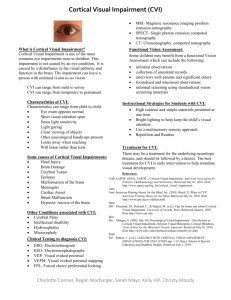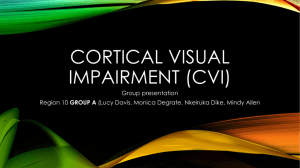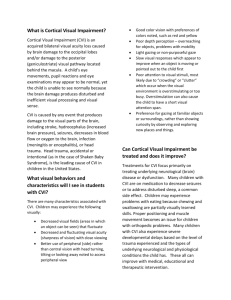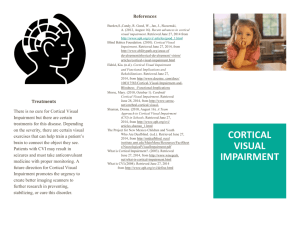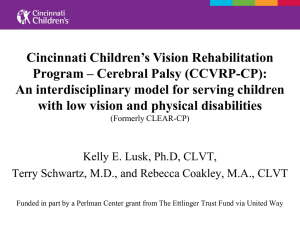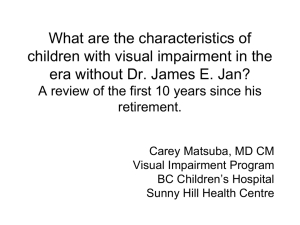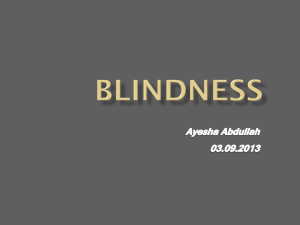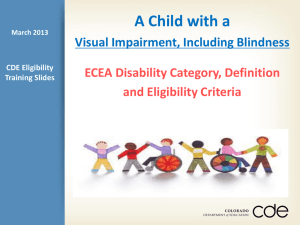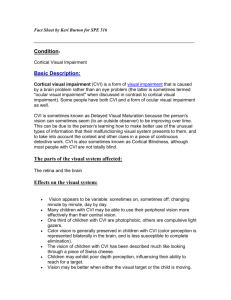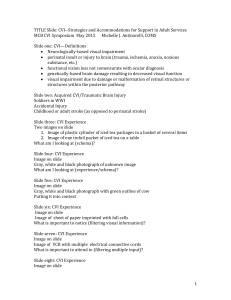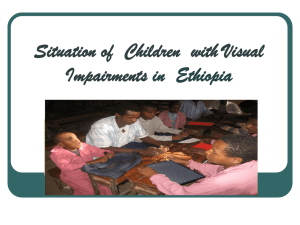Associated Conditions
advertisement
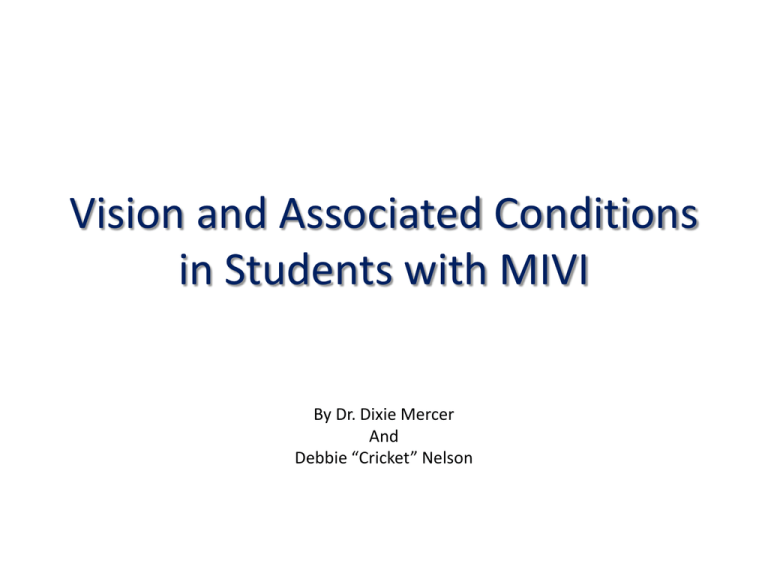
Vision and Associated Conditions in Students with MIVI By Dr. Dixie Mercer And Debbie “Cricket” Nelson Cerebral Palsy •Any number of neurological disorders because of injury to the brain, that appear in infancy or early childhood and permanently affect body movement and muscle coordination but don’t worsen over time. •Vision problems •Strabismus •Nystagmus •Cortical Blindness •Hemnianopsia •Other Problems •Muscle tone •Difficulties swallowing, sucking, speaking •Hearing problems •Speech problems •Seizures Cerebral Palsy CHARGE • C Coloboma defects of the Syndrome eyeball and cranial nerve abnormalities Rare disorder • H Heart defects • A Atresia of the choanae Happens during early fetal development Affects multiple organ systems (blocked nasal breathing passages) • R Retardation of growth and development • G Genital and urinary abnormalities • E Ear abnormalities and hearing loss CHARGE • • • • • CAUSES VISION LOSS in 80%-90% of cases Coloboma (like a cleft) of the eye Coloboma of the iris, retina, choroid, macula or disc Microphthalmos (small eye) Anophthalmos (missing eye) – – – – – – Visual field loss, typically in the superior (upper) field Blind spots Acuity problems Extra sensitivity to bright lights (even indoors) Monocular vision Lack of depth perception • There are only a handful of documented examples of more than one child with CHARGE in a family. CHARGE Syndrome Cortical Visual Impairment (CVI) •A neurological visual disorder. •It is the fastest growing visual impairment diagnosis today. •It involves a disturbed visual sense because of widespread brain disturbance and damage. Definition for Educational Purposes: Cortical visual impairment (CVI) is a neurological disorder, which results in unique visual responses to people, educational materials, and to the environment. When students with these visual/behavioral characteristics are shown to have loss of acuity or judged by their performance to be visually impaired, they are considered to have CVI. CVI Cytomegalovirus (CMV) (si-to-MEG-a-lo-vi-rus) A member of the herpes virus family, it is the most common congenital (present at birth) infection in the United States. ~30,000 children each year! • Vision Problems: – Central vision loss – Blurred vision – Cortical vision impairment – Blindness – Scarring of the retina – Swelling and irritation of the eye (uveitis) – Retinitis – Photophobia (light • Other Problems: – Hearing loss – Mental disability – Small head – Lack of coordination – Seizures – Death – Vision loss CMV cytomegalovirus (si-to-MEG-a-lo-vi-rus) Encephalitis An acute infection and inflammation of the brain. The most common cause of this is viral infections Associated Vision Problems • Light Sensitivity • Double Vision • If in the Occipital lobe: Responsible for interpreting visual input from the eyes Other Problems • Unsteady gait • Disorientation • Body Stiffness • Muscle weakness • Permanent brain damage • Parietal lobe: Processes information from the senses and controls walking, posture, and head and eye movements. Hydrocephalus Abnormal buildup of the brain’s normal water-like fluid (cerebrospinal fluid or CSF). A disturbance of formation, flow, or absorption of cerebrospinal fluid (CSF) that leads to an increase in volume occupied by this fluid in the CNS Associated Vision Problems Other Problems • • • • • • • • • • • • • Eyes fixed downward Swelling of the optic disk Blurred vision Blindness Increased pressure on the optic nerves • Eyes that appear crossed • Uncontrolled eye movements Unusually large head Seizures Developmental delay Poor coordination Developmental delays Learning disabilities Mental retardation Slow movement, lethargy, other physical disabilities. Meningitis •An inflammation of the meninges, the membranes that cover the brain and spinal cord. •Usually caused by bacteria or viruses, but it can also be caused by certain medications or illnesses. Associated Vision Problems •Blindness •Double vision •Cortical visual impairment •Photophobia •Blurry or hazy vision •Problems with depth perception •Partial loss of the visual field •Loss of central vision Microcephaly • A medical condition in which the circumference of the head is smaller than normal because the brain has not developed properly or has stopped growing. •Vision problems: •CVI •Eye development problems •Structural impairment •Damage to one or more parts of the eye •Refractive errors •Vision fluctuation •Other problems: •Convulsions & seizures •Mental retardation •Developmental delays •Delayed motor functions and speech •Facial distortions •Dwarfism •Hyperactivity Microcephaly Retinopathy of Prematurity (ROP) •A potentially blinding eye disorder that primarily affects premature infants weighing about 2¾ pounds (1250 grams) or less that are born before 31 weeks of gestation (A full-term pregnancy has a gestation of 38–42 weeks). •One of the most common causes of visual loss in childhood and can lead to lifelong vision impairment and blindness. •Usually develops in both eyes. •Caused by disorganized growth of retinal blood vessels, resulting in scarring and retinal detachment. Retinopathy of Prematurity (ROP) Severity described in Stages: •Stages 1 & 2 do not lead to blindness, but can progress to the more severe stages. •Stage 3 has a 50% likelihood of progressing to retinal detachment. •Stage 4 is partial retinal detachment •Stage 5 is total retinal detachment http://www.aboutkidshealth.ca/En/ResourceCentres/PrematureBabies/AboutPrematureBabies/OtherCo nditions/Pages/Retinopathy-of-Prematurity-ROP.aspx Shaken Baby Syndrome (SBS) or Abusive Head Trauma (AHT) A severe form of head injury caused by violently shaking an infant or child. • Associated Vision Problems – Partial or total blindness – Unequal pupil size – Inability to focus the eyes – Inability to track movement – Retinal hemorrhages Shaken Baby Syndrome (SBS) or Abusive Head Trauma (AHT) Other Problems: • Damage to the spinal cord and neck • Permanent brain damage • Severe neurological consequences • Life-threatening central nervous system dysfunction • Fractures of the ribs, skull and bones. • Decreased level of consciousness • Difficulty staying awake • Breathing problems • Poor eating • Pale or bluish skin • • • • • • • • • • • • • Seizures Cerebral palsy Partial or total blindness Limp arms and legs or rigidity/posturing Learning disabilities Physical disabilities Hearing impairment Speech disabilities Behavior disorders Cognitive impairment Developmental delays Extreme irritability Paralysis Shaken Baby Syndrome (SBS) Spina Bifida “Cleft spine”; a neural tube birth defect in which the backbone and spinal canal do not close before birth Incomplete closure of the spine Associated Visual Characteristics • Cerebral Visual Impairment (CVI) • Visual Field Loss • Optic Atrophy • Nystagmus • Depth Perception problems • Problems recognizing faces/places/items, etc. • Strabismus • Hydrocephalus can put pressure on the optic nerve Problems • Hydrocephalus • Syringomyelia • Hip dislocation • Loss of bladder or bowel control • Partial or complete lack of sensation • Partial or complete paralysis of the legs • Weakness of the hips, legs, or feet of a newborn • Abnormal feet or legs (such as a clubfoot) Traumatic Brain Injury •Blurry or double vision (diplopia) •Anxiety, nervousness •Behavioral changes: •difficulty controlling urges (disinhibition) •impulsiveness •inappropriate laughter •irritability •Depression •Difficulty concentrating or thinking •Difficulty finding words or understanding the speech of others (aphasia) •Slurred and/or slowed speech •Difficulty swallowing (dysphagia) •Dizziness, lightheadedness Traumatic Brain Injury cont’d •Headaches •Difficulty in coordination of movements •Loss of balance; difficulty walking or sitting •Loss of memory •Muscle stiffness and/or spasms •Seizures •Sleep difficulties (more or less sleep than preinjury) •Tingling, numbness, pain, or other sensations •Sense of spinning (vertigo) •Weakness in one or more limbs, facial muscles, or on an entire side of the body Common Causes of TBI Motor vehicle, bicycle, or vehiclepedestrian mishaps (more than 50%) Falls (approximately 25%) Violence (nearly 20%) About 3% of injuries are the result of sport injuries Shaken Baby Syndrome is a form of TBI Usher Syndrome • Inherited. •The most common condition that affects both hearing and vision. •Progressive hearing & vision loss. •Retinitis Pigmentosa, or RP •night-blindness •peripheral vision loss •tunnel vision •Hearing loss •Severe balance problems. •Other problems: •Delayed language skills •Delayed motor skills Usher Syndrome The optic nerve (arrow) looks very pale, the vessels (stars) are very thin, and there is characteristic pigment, called bone spicules (double arrows).

